Accumulation and geochemical evidence for the Little Ice Age episode in eastern Antarctica
ChuanJin Li,JiaWen Ren,CunDe Xiao,2,MingHu Ding,3,AiHong Xie,ZhiHeng Du,XiangYu Ma,DaHe Qin
1.State Key Laboratory of the Cryospheric Science,Northwest Institute of Eco-Environment and Resources,Chinese Academy of Sciences,Lanzhou,Gansu 730000,China
2.State Key Laboratory of Earth Surface Processes and Resource Ecology,Beijing Normal University,Beijing 100875,China
3.Institute of Climate System(Polar Meteorology),Chinese Academy of Meteorological Sciences,Beijing 100081,China
ABSTRACT Data on accumulation and concentration of chemical compounds recorded in an essentially unexplored area(Dome Argus)of the Indian Ocean sector of eastern Antarctica during the past 2,680 years(680 B.C.to 1999 A.D.)are presented.During the first 1,700 years(680 B.C.to 1000 A.D.),the accumulation data shows a slightly decreasing trend,while chemical ions appear to be stable,representing a stable climatic condition.An intensive increasing trend of the accumulation occurred during the 12thto 14thcentury.The period from 15thto 19thcentury was characterized by a rapid reducing accumulation and concentrations of volatile compounds suffering post-depositional loss linked to sparse precipitation amount,which was temporally consistent with the Little Ice Age(LIA)episode.Comparison between observed accumulation rates with other eastern Antarctic ice cores show a consistent decreasing trend during LIA,while sea salt and dust-originated ions increased due to sea ice extent and intensified atmospheric transportation.Distribution of volcanic originated sulfate over the Antarctic continent show a significant change during the 15thcentury,coincident with the onset of the LIA.These results are important for the assessment of Antarctic continent mass balance and associated interpretation of the Dome A deep ice core records.
Keywords:accumulation rates;sea salt;chemical compounds;Little Ice Age;eastern Antarctica
1 Introduction
To better understand natural climate forcing factors,such as solar activity and volcanic eruptions,it is important to study the climate system and anthropogenic influences through greenhouse gases and other atmospheric components(Li et al.,2009;IPCC,2013).Basic knowledge on climate change during the past two millennia is highly relevant for understanding the global climate system and predicting future climate variations(Bradley and Jones,1993;Crowley,2000).
The Little Ice Age(LIA,about 1400-1800 A.D.)is a prominent multi-century scale climate episode during the past two millennia,which show a relatively cold climate performance(Kreutz et al.,1997;Li et al.,2009).Numerous studies have been conducted on LIA's climatic performance,duration and possible causes(Kreutz et al.,1997;Wang et al.,2017).To better understand climate variability during this neogla-cial episode,the first step is to find the evidence for its existence worldwide.Extensive evidence of the LIA has been detected in the Northern Hemisphere(Bradley and Jones,1993;Kreutz et al.,1997;Miller et al.,2012);however,there is limited evidence in low latitudes and the Southern Hemisphere(Kreutz et al.,1997;Li et al.,2009).
LIA show different climatic performances in different Antarctic ice cores(Kreutz et al.,1997;Morgan and Van Ommen,1997;Karlöf et al.,2000;Sommer et al.,2000;Mulvaney et al.,2002;Mayewski and Maasch,2006;Li et al.,2009).LIA show intensive increasing trends of Na+and Ca2+during 1000-2000 A.D.in the Siple Dome in western Antarctica(Mayewski and Maasch,2006),while decreases of accumulation rate and volatile chemical compound concentrations were detected in the DT263 ice core(Li et al.,2009).Here,we present a new accumulation and geochemical evidence for the existence of the neoglacial episode in the DT-401 ice core,which lies in the Indian Ocean sector of eastern Antarctica.DT-401 is located 120 km from the highest point of the eastern Antarctica Plateau(Dome A)and share similar geographic and climatic conditions with Dome A(Ren et al.,2010).Dome A is a potential site for ice cores more than one million years old(Xiao et al.,2008;Zhang et al.,2014).The deposition of sea salt originated chemical compounds(Na+,Cl-,Mg2+)and long range transported chemicals(Ca2+,)associated with Antarctic atmospheric circulation were studied from the DT-401 ice core.This study will provide important information for the interpretation of the Dome A ice core records(Ren et al.,2009).
2 Samples and data
During the 15thChinese National Antarctica Research Expedition(CHINARE),which was conducted during November 1999 to April 2000,an ice core with the length of 102.65 m was collected at the DT-401 site(79°01′S,77°00′E,3,760 m a.s.l.)(Figure 1).The mean annual accumulation rate during 2000-2005 measured by in situ observations was 0.025±0.016 m H2O/a(Xiao et al.,2008;Ren et al.,2010).Clear sky precipitation(diamond dust)predominates through the deposited mass(Hou et al.,2007).No annual mean air temperature was measured at the DT-401 site,but speculation of-54.3°C is based on the interpolation method from temperatures recorded at Dome A,Zhongshan station and DT263 together with their elevation data(Ren et al.,2004,2010).This temperature is among the lowest in eastern Antarctica and is similar to the temperature at Dome F,Dome C and Vostok,but slightly higher than those in Dome A and Dome B(Xiao et al.,2008).
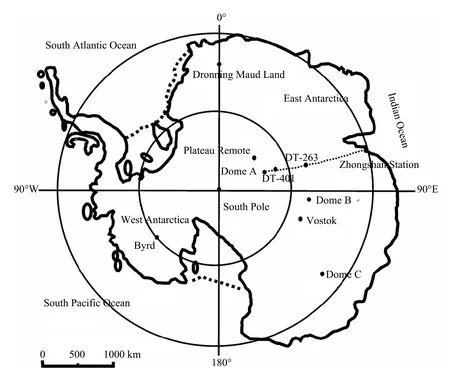
Figure 1 Location of the DT-401 ice core site and other ice core sites in East Antarctica(solid dots),also the CHINARE expedition route from Zhongshan Station to Dome A(dashed line)
During the DT-401 ice core drilling process,a snow pit with a depth 2.04 m was excavated firstly with a vertical resolution of 3 cm.A total of 68 snow and firn samples were collected.All the samples were sealed in pre-cleaned polyethylene sampling bottles and remained frozen until laboratory analysis.To minimize contamination,clean isolation clothes,gloves and masks were worn during sample collection procedure.After snow pit sampling,a 100.61 m ice core with a diameter of 9 cm was obtained at the bottom of the snow pit with an electrical mechanical drill in a dry hole.A total of 161 sections of ice core with the average length of 80 cm were collected.Following extraction,the length and weight of each ice core section was measured for density calculations,and physical characteristics such as firn and hardness were also examined and recorded(Ren et al.,2010).All ice core sections were sealed in clean plastic bags and transported in a frozen state(-15°C)to the State Key Laboratory of the Cryospheric Science(SKLCS)in Lanzhou,China and stored in the freezer(-18°C)until analysis.Clean sample processing procedures and trace chemicalionsanalysiswasconducted in SKLCS.The analyzing equipment for the ions was the Dionex-600 ion chromatograph with the analyzing columns CS-12 and AS-11 for cations and anions,and protecting columns were CG-12 and AG-12,respectively.More detailed information for the analysis please refer to Ren et al.(2010).Stable isotope ratios were analyzed by the CO2-H2O/Zn-H2O equilibrium method with a mass spectrometer(Finnigan MAT-252)at the SKLCS.The isotopic composition is reported in terms of the standard δ18O and δD values representing differences in18O/16O and D/H ratios between the sample and the standard VSMOW.The measurement accuracy is estimated to be within 0.15%for δ18O and within 1%for δD,respectively(Xiao et al.,2013).
Dating of the DT-401 ice core was based on volcanic deposition signals,β-activity data,accumulation rates,and the Herron and Langway firn densification experiential model(Ren et al.,2010).The entire ice core is speculated to cover a duration of 2,680±40 years(for detailed procedures,please refer to Ren et al.(2010)).The accumulation rates were calculated for the whole duration based on dating results,the lengths and densities of the ice core sections.
Movement of ice,especially for that with different velocity field in different depths can affect the accurate interpretation of ice-core records(Yang et al.,2014).No measurement of the movement velocity was conducted at DT-401.However,because of the short distance from Dome A and the low velocity of the ice movement at Dome A(11.1±2.4 cm/a,Yang et al.,2014),we speculated that the influence of ice movements on the DT-401 ice core records during the past 2,680-year was negligible(Fischer et al.,2007).
Empirical orthogonal function(EOF)analysis was used in this study.EOF is based on principal component analysis of multivariate statistics,and analysis of the glaciochemical time series was used to identify their sources and the relationships with climatic variables(Kreutz and Mayewski,1999;Souney,2002;Xiao et al.,2004).EOF decomposed the time series into uncorrelated components,and shown with the maximum amount of residual variance sequentially(Xiao et al.,2004).Major ions(Na+,Ca2+,Mg2+,Cl-,,and)and δ18O records in the DT-401 ice core were included in the EOF analysis(Li et al.,2015).
3 Results and discussion
3.1 Accumulation rate
Variations of the accumulation rates were firstly investigated.Due to the low annual accumulation in the interior area of eastern Antarctica,it was not possible to obtain climatic information at seasonal or annual time scales.Hence,in the subsequent analysis,the accumulation data of DT-401 ice core presented here is based on 10-year and 30-year mean values(Figure 2).
From 680 B.C.to 700 A.D.,the accumulation decreased from 0.038 to 0.028 m H2O/a(Figure 2),and in the following four centuries(700 to 1100 A.D.),the accumulation rate was stable with mean values about 0.026 m H2O/a.From the 11thcentury to the end of the 13thcentury,the accumulation increased rapidly from 0.025 to 0.050 m H2O/a.In the following half-century(1300-1350 A.D.),the accumulation stayed around 0.050 m H2O/a.A decreasing trend around 1300 A.D.resulted in a"double peak"pattern in peak values.Then,accumulation decreased significantly from 0.048 to 0.015 m H2O/a during 1390-1950 A.D..This period with lower accumulation rate is temporally consistent with the LIA episode.Detailed information on the variation occurring during the LIA episode shows a sharply decreasing trend from the end of the 14thcentury to the end of the 19thcentury.Subsequently,another significant increase from 0.015 to 0.026 m H2O/a during 1950 to 1999 A.D.was observed.
Based on dating results for the DT-401 ice core(Ren et al.,2010),we calculated the mean annual accumulation between the six volcanic tie points(Agung 1963 A.D.,Krakatoa 1883 A.D.,Tambora 1815 A.D.,Unknown 1809 A.D.,Kuwae 1454 A.D.and Unknown 1259 A.D.)showing high volcanic eruption indices(VEI)during the past millennium.Five additional eastern Antarctic ice cores,Plateau Remote(PR-B)(Cole-Dai et al.,2000),Dronning Maud Land(DML)(Traufetter et al.,2004),DT263(Xing et al.,2006),DT-401(this study)and Dome A(this study)were also included in the research to synthetically study the spatial and temporal variations of accumulation rates in the eastern Antarctic ice sheet(Figure 3).These results are important for large-scale assessment of the Antarctic mass balance and model validation(Anschütz et al.,2011).A general decreasing trend of accumulation with increasing distance from the coast(continentally)was detected in eastern Antarctica(Ding et al.,2011,2015).Among the five ice cores,DT263 shows the highest accumulation rate,while the Dome A ice core shows the lowest during the past millennium(Li et al.,2009,2012).Otherwise,observed variations in accumulation rates shows that the five ice cores had similar patterns between the volcanic tie points.Accumulation rates for all sites were highest during 1259-1454 A.D.and decreased significantly during 1454-1809 A.D..However,the decrease in accumulation rates at the different ice core sites vary,with the highest accumulation rate occurring for DT263.After 1809 A.D.,different variation trend of accumulation rates were detected in different ice cores.DML shows a consistent increasing pattern between 1809 A.D.and 1999 A.D.,while PR-B and Dome A exhibited a decreasing trend.The accumulation rate in the DT-401 ice core displayed a decreasing trend between 1809 A.D.and 1883 A.D.and was followed by an increase during 1883-1963 A.D..DT263 shows the most intensive increase during 1883 A.D.and 1963 A.D.and the accumulation rate reached 0.12 m H2O/a.Moreover,the other two shallow ice cores drilled at LGB69(Xiao et al.,2013)and LGB65(Xiao et al.,2004)in Lambert Glacier were also included in the comparison and they both show higher accumulation rates(0.27 m H2O/a and 0.13 m H2O/a for LGB69 and LGB65,respectively,not presented in Figure 3)than other ice cores and this may be associated with its shorter distance to the oceans.LGB69 and LGB65 ice cores both show lower accumulations for the beginning period(1700 A.D.to 1809 A.D.)and were consistent with other ice cores.
The lower accumulation rates and concentrations of chemical ions observed during 1450 A.D.-1850 A.D.in the DT263 ice core may demonstrate the existence of an LIA signal in the inland area of Princess Elizabeth Land(Li et al.,2009).The co-variation of accumulation rate observed in the five ice cores may further support the speculation that the LIA signal exists across inland eastern Antarctica.However,different variation trends of accumulation rates at different Antarctic sites may be correlated with different patterns of the response to climatic change,and a post-depositional effect(such as drifting snow,evaporation,sublimation)may also be responsible for these differences(Cole-Dai et al.,1997,2000;Castellano et al.,2004,2005).
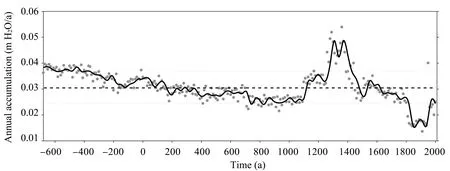
Figure 2 Variations in accumulation rate in the DT-401 ice core during the past 2,680 years.The gray dots represent the 10-year mean values,and solid black line represents the 30-year average values.The dashed line in the middle indicates the mean value(0.031 m H2O/a)for the period
3.2 Chemical compounds and climatic variations
The concentrations of chemical compounds,rather than their flux values(annual ice accumulation rate multiplied by ion concentration),are used in this study.Previous investigations have shown that variations in ice accumulation on an annual scale are not statistically associated with ion concentrations(Meese et al.,1994;Mulvaney and Wolff,1994;Meeker et al.,1997;Kreutz and Mayewski,1999;Souney et al.,2002;Mayewski and Maasch,2006),so only the concentration variations were studied here.
Na+,Mg2+are usually considered as proxy records of sea salt aerosols from the surrounding oceans.For the entire period covered by the DT-401 ice core,the correlation coefficient(R)for Na+and Mg2+was 0.62(n=2,680;p=0.01),implying that the two ions mainly come from the same source(Reusch et al.,1999;Li et al.,2009).In the EOF analysis,the first factor(EOF1)accounts for 33.9%of the total explained variance,Mg2+and Na+explained 77.5%and 61.7%of the variance in the EOF1,implying that the sea salt input is the dominant source of deposition of chemical matter in the interior of the eastern Antarctic continent.However,there is disagreement in the source regions of sea salt aerosol arriving in interior eastern Antarctica(Wolff et al.,2003).Some studies pointed out that sea salt aerosols originated from the sea ice region,where the"frost flower"containing high concentration of sea salt ions dominated the supply(e.g.,Wolff et al.,2003),while others regard the open sea water near the continent as the major contributor,with the air mass mainly being transported through atmospheric transport(Russell and McGregor,2010 and references therein).Some studies illustrated that the sea ice cover is the main contributing factor to the sea salt input in the coastal region of Antarctica(Wagenbach et al.,1998).Nevertheless,for the interior region of the continent,this remains an uncertain issue,and further efforts are needed in future studies(Wolff et al.,2003).
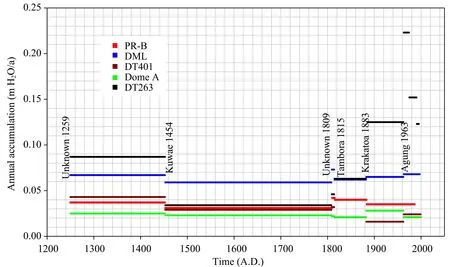
Figure 3 Accumulation rates between volcanic events(Unknown 1259 A.D.,Kuwae 1454 A.D.,Unknown 1809 A.D.,Tambora 1815 A.D.,Krakatoa 1883 A.D.and Agung 1963 A.D.)for five ice core locations in eastern Antarctica.Ice core locations are PR-B(red),DML(Blue),DT-401(brown),Dome A(green)and DT263(black)
Cl-is also sea salt originated,however,due to the low accumulation at DT-401 site and the specific irradiation and precipitation conditions,deposited Cl-would experience a series of physical and chemical transitions before it is buried in the snow layer(Li et al.,2009).The mean concentrations of Na+and Cl-found during the period covered by the snow pit samples(80 years)were 28.97±18.31 and 45.23±21.47 ng/g(n=68),respectively.According to the spatial distribution pattern of sea salt ions from Zhongshan Station to interior plateau areas(Qin et al.,2014),the concentrations of Na+and Cl-determined in the DT-401 snow pit samples were all similar to those from inland sites.The ratio of Cl-to Na+in the snow pit samples,covering the most recent 80 years,was 2.54±3.18(n=69),while for the entire period covered by the DT-401 ice core,the mean ratio was 2.98±3.60(n=2,620).Given the Cl-/Na+weight ratio in bulk sea water(1.81)(Broecker and Peng,1982;Traversi et al.,2004),the higher ratio found in the interior DT-401 location means that sources other than sea salt have contributed to the load of Cl-(Suzuki et al.,2002).Previous studies conducted in the interior areas of the Antarctic ice sheet have shown similar results(e.g.,Wagnon et al.,1999;Suzuki et al.,2002).A decreasing trend of sea salt ions from the coast to the interior continent implies that the contribution of the marine input is weakened as the distance inland increases(Suzuki et al.,2002).However,an enlarged source area(sea ice extent)and intensified atmospheric circulation may partially account for the increase in sea salt concentrations(Mayewski and Maasch,2006).Otherwise,the reactions between gaseous acids(e.g.,HNO3)and Na-Cl in the boundary layer may also account for the excess chloride deposition(Donaldson and George,2012;Zhao et al.,2016).The Siple Dome site shows an increasing trend of Na+from 1000 A.D.to 2000 A.D.,which is consistent with the duration of the neoglacial episode(LIA),and prior to that time,the period presenting low Na+concentrations is well correlated with the medieval warm period(MWP)(Mayewski and Maasch,2006).
In the DT-401 ice core,Na+show low,stable concentrations from 680 B.C.to 1450 A.D.and an intermediate amplitude of variation.No significant trend of variation was detected during the duration of the MWP episode.However,the concentration shows an increasing trend beginning in 1450 A.D.,accompanied by higher amplitude of variation.During the entire LIA episode,Na+and Mg2+concentrations in-creased by 38.3%and 17.1%,respectively.Different trends of variation were found between Na+and Cl-.The enlarged sea ice area during the LIA period may be responsible for an increase of Cl-in DT-401,however,it shows a decrease compared to Na+during 1600-1950 A.D..The sharp decrease in Cl-during this period suggests that an additional factor,also accounting for the NO3-decreases(Wolff et al.,2002,2008;Li et al.,2009,2013),may be responsible for the more significant loss of Cl-.Reactions between sea salt particles and acid aerosols in the air can convert Cl-in sea salt into HCl(Legrand and Delmas,1985,1988;Langway et al.,1994;Legrand and Mayewski,1997).Similar reactions are also likely to occur in the snowpack(Wagnon et al.,1999),generating HCl,which can be emitted as a gas from the snow surface,similar to the mechanism ofloss.In general,the post-depositional loss of volatile compounds from the snowpack is more severe in locations with extremely low accumulation rates(Wagnon et al.,1999;Röthlisberger et al.,2000;Weller et al.,2004),indicating that the loss of gaseous compounds is enhanced by reduced snow accumulation rates.As such,the extremely low concentration of Cl-during the period from 1600-1950 A.D.is consistent with the sharply decreased accumulation rates during this period.
Different trends of variation can be observed for Na+in the DT263 and DT-401 ice cores during the LIA,with a slightly altered trend of variation or small decrease being detected in the DT263 ice core,while a significant increasing trend was found in DT-401.Li et al.(2009)ascribed this decrease to the enlarged distance from the open sea water around the continent under colder climatic conditions.However,the increasing trend detected for Na+in DT-401 during the LIA was associated with an enlarged sea ice area.Intensified atmospheric circulation during cold periods may be another influencing factor(Russell and Mc-Gregor,2010).Because of the lack of empirical data for eastern Antarctica,we cannot provide a clear explanation for this difference.Contrasting different transport mechanisms at the two locations as well as varying post-depositional effects may be responsible for this difference(Li et al.,2009;Ren et al.,2010).
Ca2+deposition in the eastern Antarctic is usually associated with the dust input originating from southern South America(SSA)(Delmonte et al.,2007).For the inner sites(i.e.,Dome C,Dome B and Vostok),a mixed Australian and SSA dust input is expected on the basis of geochemical evidence(Revel-Rolland et al.,2006;Delmonte et al.,2007;Marino et al.,2008,2009;De Deckker et al.,2010;Gabrielli et al.,2010).The intensified atmospheric circulation during cold climatic stages can also help to strengthen the dust input(Mayewski and Maasch,2006).Intensified circulation of Southern Westerlies is conducive to the transport of more crustal aerosols to the Antarctic Siple Dome site(Yan et al.,2005).During the Last Glacial Maximum and early deglaciation stage,the westerly circulation regime allowed an ef fi cient transfer of dust from southern South America to most of the East Antarctic Plateau(Delmonte et al.,2010a).Cold climatic stages are not only associated with the intensified atmospheric circulation which will transport more dust to the interior sites,but also can increase the amount of dust from the source regions(Basile et al.,1997;Marino et al.,2009;Delmonte et al.,2010b).
The concentration of calcium(Ca2+)(Röthlisberger et al.,2002)recorded in the DT-401 ice core show a relatively stable fluctuation pattern from 680 B.C.to 1000 A.D..Subsequently,a period with extremely low concentrations occurred from 1000-1450 A.D.,presenting an approximately 16.1%reduction compared with the earlier period.This period is temporally consistent with the duration of the warm climatic stage(MWP).After 1450 A.D.,high concentrations were observed,implying that strengthened atmospheric circulation had returned,accompanied by the beginning of the LIA.However,a decreasing trend similar to that found for Na+and Mg2+could also be detected for Ca2+from 1500-1700 A.D.,showing that climatic conditions during the LIA duration were unstable.Beginning in 1700 A.D.,high Ca2+concentrations with high amplitude of variation(Table 1)occurred,and two peak concentrations were observed in 1810 A.D.and 1950 A.D.,respectively,showing that the atmospheric circulation has intensified during the latest two centuries.
In addition to the sea salt origin and the occasional brief time periods impacted by explosive volcanic eruptions,a portion of the non-sea-salt sulfate load(nss)on the snow surface in the interior area of the Antarctica originally came from the oxidation of dimethyl sulfide(DMS)emitted by phytoplankton metabolic activities at the ocean surface(Saltzman et al.,1995;Becagli et al.,2004).Aerosol measurements(Minikin et al.,1998)and modeling exercises(Cosme et al.,2005)suggest that most of the marine sulfur compounds originate from the high and mid-latitude Southern Ocean.As a result,non-volcanic nss-(years with known and probable volcanic sulfate have been removed from the time series)is not significantly impacted by Holocene climatic variations in the high southern latitudes(EPICA Community Members,2004).This may be the reason for the relatively stable non-volcaniclevels observed during the last 2680 years at this interior location(data not shown),when significant climatic shifts appear to have occurred(Li et al.,2009).The prominentpeak values correspond well to volcanic events during the past 2,680 years in the DT-401 ice core,where 36 volcanic deposition signals were detected.Detailed information about volca-nic deposition signals can be found in Ren et al.(2010).To further explore volcanic deposition on the Antarctic continent and the possible climatic information that can be deduced from such data,the distribution pattern of volcanic deposition over the Antarctic continent was investigated.The same method applied by Castellano et al.(2005)was used here,but for different Antarctic sites,PR-B(Cole-Dai et al.,2000),EDC(Castellano et al.,2005),Siple(Cole-Dai et al.,1997),Dyer(Cole-Dai et al.,1997),South Pole(SP)(Delmas et al.,1992),DT263(Xing et al.,2006),Byrd(Langway et al.,1994),Dronning Maud Land(Traufetter et al.,2004)and Dome A(Hou et al.,2007;personal communication)).First,the ratio of the deposition flux of each volcanic event during the latest millennium to that of Tambora(1815 A.D.)was calculated,which effectively reduces the influence of regional differences on the depositional characteristics of each event(Castellano et al.,2005).Statistical results for the volcanic deposition ratios show that there were major regional differences both before and after 1500 A.D..Prior to this time,higher amplitude of regional variation could be detected,and a highly concentrated variation pattern was found thereafter(Figure 5),which may be connected to changes in atmospheric circulation patterns under different climatic conditions.The polar vortex encircling the Antarctic continent show a weak pattern under a warm climate,and volcanic matter from beyond the Antarctic continent can rapidly penetrate into the interior part of the ice sheet and deposited on the surface,causing an uneven distribution over the continent.However,during cold periods,the intensified polar vortex can effectively obstruct the incursion of volcanic matter,which should then undergo a long journey,encircling the continent before arriving in the inland region of the Antarctica,ultimately resulting in a more evenly distributed pattern(Castellano et al.,2005).The period before 1500 A.D.corresponded well to the duration of the MWP,while the LIA subsequently dominated climatic fluctuations.The temporal distribution pattern observed for volcanic matter may further illustrate the existence of the two climatic events in the interior region of the Antarctic ice sheet.
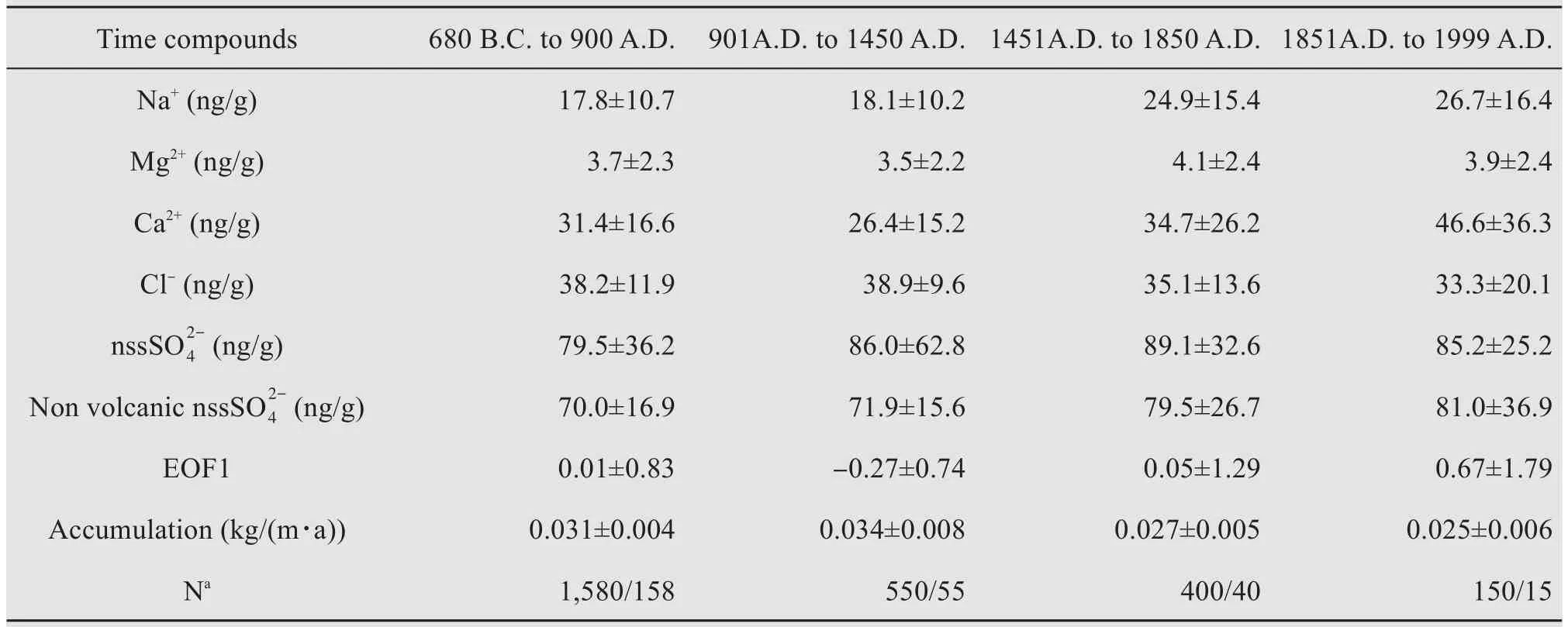
Table 1 Temporal variation of the average concentrations of sodium,magnesium,nss calcium,chloride,nss sulfate,non-volcanic nss sulfate,EOF1 and accumulation rates in DT-401 ice core
The stable isotope composition of water(δ18O and δD)in ice cores has been used as proxies for troposphere temperatures(Li et al.,2009;Xiao et al.,2013).Data on δ18O during the past 2,680 years from the DT-401 ice core are presented in Figure 4.In general,δ18O show a consistently increasing trend,though some decreasing interruptions occurred periodically.No significant decreasing trend was detected during the LIA episode;on the contrary,a general increasing trend was detected from 1450-1850 A.D..Reduced precipitation rate is usually accompanied with colder temperatures such as those observed during glacial periods in polar ice core records(Petit et al.,1999;EPICA Community Members,2004).These conflicting observations led us to consider the possibility that the recent LIA episode may or may not have been recorded in the δ18O proxy(Li et al.,2009).Stable isotopes found in precipitation represent not only local conditions,where precipitation occurs,but also a combination of source conditions,snowfall,and post-deposition processes.The LIA signal in the Siple Dome ice core from western Antarctica was represented by increased wind intensities and circulation variability,but not by decreased iso-tope contents in the ice(Kreutz et al.,1997).Instead,somewhat warmer conditions during this period may have prevailed in parts of western Antarctica(Mosley-Thompson,1992;Kreutz et al.,1997),which has been attributed to the enhanced influence of warm marine air masses during the LIA(Kreutz et al.,1997).The northward movement of regions that serve as moisture sources is another potential factor(Reijmer et al.,2002).The temporal variability in moisture source regions is on the order of 3°of latitude.From 1979 to 1993 A.D.,a signi fi cant northward trend was found regarding moisture source regionsatthe DML05 site(Reijmer et al.,2002).Based on the findings of Wang et al.(2013),Dome A mainly receives moisture from the mid-latitude(46°S±4°S)South Indian Ocean,showing a seasonal latitudinal shift of approximately 6°.The post-depositional effect may be another cause of the different temporal distribution series of δ18O values observed in the DT-401 ice core.There is evidence that the isotopic composition of snow may reflect single-season temperatures due to the preservation of only a single season's snow at a given site(Morgan and Van Ommen,1997),particularly at locations with low accumulations.The extremely low snow accumulation during the LIA period detected at the DT-401 site raised the possibility that only winter or summer snow was preserved and recovered in this ice core(Ren et al.,2010).

Figure 4 Temporal variation of the concentrations of(a)Na+,(b)Cl-,(c)Mg2+,(d)Ca2+,(e)nssand(f)δ18O.Thick lines represent 30-year smoothed data
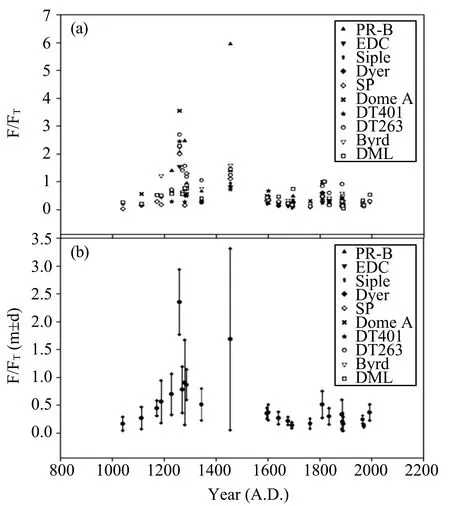
Figure 5 (a)The ratios between fluxes of events recorded in ten Antarctic ice cores and Tambora(used as reference event)are reported against age for the last millennium.(b)The standard deviation for the considered events is indicated.References are reported in the text
4 Conclusions
The deposition of atmospheric mass at the DT-401 site in eastern Antarctica during the past 2,680 years provides us with the opportunity to investigate climatic variability and potential mechanisms influencing this variability.A weak,consistent decreasing trend of accumulation was found for the initial 1,800 years of this period(680 B.C.-1100 A.D.).Significant increasing trend followed during the 12thto 14thcenturies and this period was temporally consistent with the MWP event.Then,consistent,sharp decreases in accumulation were observed during the following five centuries(15thto 19thcenturies);this period was consistent with the LIA episode.Na+and Mg2+ions show an increasing trend during the LIA episode,which may be associated with the increased extent of sea ice during the cold event.The concentration of Cl-ions decreased intensively during the 17thto 20thcenturies,corresponding to a period with quite low accumulation rates;the post-depositional loss of volatile compounds at this site with low accumulation may have been the main reason for this decrease.Ca2+also show a higher concentration during the LIA,and this increasing trend may have been associated with increased sources and intensified transport intensities during the cold period.No significant trend of variation was found for the concentration of non-volcanic nss.However,the temporal distribution of volcanic matter over the Antarctic continent show a significant change during the 15thcentury and coincident with the onset of the LIA.The variation of the atmospheric circulation pattern(polar vortex)under different climatic conditions was responsible for this change.There was also no prominent shift of the stable oxygen isotope ratio during the LIA episode,for which there are many possible explanations in this interior site of eastern Antarctica,where extremely low accumulation is observed.Further efforts will be required to reveal the causes of these findings.
DT-401 is located near Dome A,which is the highest point in the eastern Antarctic ice sheet,and the two sites have similar climatic and geographic conditions(Hou et al.,2007).Studies on the characteristics of the deposition of atmospheric matter in the DT-401 ice core are important in investigating the atmospheric circulation and possible post-depositional effects at the Dome A site.
Acknowledgments:
We thank all the members of the fifteenth and twenty first CHINARE for their help in sampling the snow pit and extracting the ice cores.Special thanks to the anonymous reviewers,their comments are important for improving the quality of this manuscript.We thank XiaoXiang Wang and XiaoQing Cui for their excellent analysis work.This study is financially supported by the National Natural Science Foundation of China(41671063,41425003,41476164,41671073,and 41721091).Supporting funds also include that from the State Oceanic Administration,the Youth Innovation Promotion Association,NIEER,and the State Key Laboratory of the Cryospheric Science.
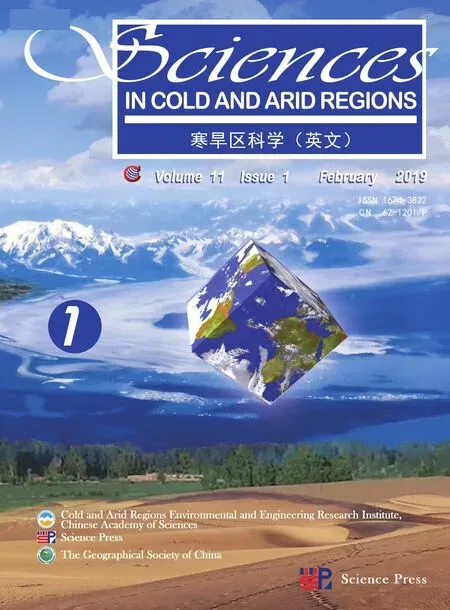 Sciences in Cold and Arid Regions2019年1期
Sciences in Cold and Arid Regions2019年1期
- Sciences in Cold and Arid Regions的其它文章
- Increase in medium-size rainfall events will enhance the C-sequestration capacity of biological soil crusts
- How changes of groundwater level affect the desert riparian forest ecosystem in the Ejina Oasis,Northwest China
- Primary investigation of statistical correlation between changes in ice volume and area of glaciers
- Vulnerability and adaptation of an oasis social–ecological system affected by glacier change in an arid region of northwestern China
- The analysis of heat and water fluxes in frozen silty soil
- The changing process and trend of ground temperature around tower foundations of Qinghai-Tibet Power Transmission line
